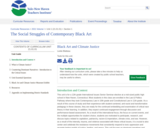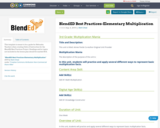
2696 Results








Life is all around us, both as multicellular organisms such as the iguana and bamboo above, as well as the unicellular microorganisms such as bacteria. Life is present on every continent, in the air and in the waters of the world. There is life even in the Mariana Trench, seven miles below the surface of the ocean. As of 2010 biologists have described and classified 1.7 million plants and animals, and estimate that there are till over five million species still undiscovered.This chapter will introduce the ways we study the science of Biology in the twenty-first century, the characteristics of living organisms and their classification.
- Subject:
- Biology
- Life Science
- Material Type:
- Unit of Study


- Subject:
- Biology
- Life Science
- Material Type:
- Unit of Study
- Provider:
- Rice University
- Provider Set:
- OpenStax College

- Subject:
- Biology
- Life Science
- Material Type:
- Unit of Study
- Provider:
- Rice University
- Provider Set:
- OpenStax College

- Subject:
- Biology
- Life Science
- Material Type:
- Unit of Study
- Provider:
- Rice University
- Provider Set:
- OpenStax College

La Biotecnología es el conjunto de técnicas, procesos y métodos que utilizan sistemas biológicos y organismos vivos, o alguna de sus partes, para la obtener o modificar una amplia variedad de productos. Entendemos la Biotecnología como un área multidisciplinar que emplea tanto la biología, la química como diferentes procesos. Se utiliza en distintos usos, como puede ser el sector de la agricultura, de la alimentación o en medicina. En definitiva se basa en utilizar la maquinaria de otros seres vivos en beneficio del ser humano.
- Subject:
- Applied Science
- Environmental Science
- Material Type:
- Unit of Study
- Author:
- Ciberimaginario Group
- Ignacio Ballesteros
- Bio3 Project
- Date Added:
- 12/19/2019

This sequence of instruction was developed to help elementary teachers who were working remotely. We developed a short storyline that ties together a few sessions to help explore a specific concept. We tried to include some activities that honored and included the student’s family and experience, and some that included the potential for ELA learning goals.Students make observations of the behaviors while watching short videos of Bald Eagles and Hummingbirds. They then make observations of birds in their own neighborhood or school grounds. They use these observations to explore th knees of these organisms and behaviors used to meet these needs.It is part of Clime Time - a collaboration among all nine Educational Service Districts (ESDs) in Washington and many Community Partners to provide programs for science teacher training around Next Generation Science Standards (NGSS) and climate science, thanks to grant money made available to the Office of the Superintendent of Public Instruction (OSPI) by Governor Inslee.
- Subject:
- Elementary Education
- Material Type:
- Unit of Study
- Author:
- Clancy Wolf
- Jeff Ryan
- Date Added:
- 08/13/2021

This unit is for a 12th grade International Issues Senior Seminar elective at a mid-sized public high school in New Haven, Connecticut. Most students in this class are enrolled in the Law & Politics Pathway where they took Contemporary Law in 10th grade and Constitutional Law in 11th grade. As a result of this course of study and their experience with student-centered, anti-racist and transformative pedagogy in these classes, they are ready for the continued embedding and examination of critical race theory in their learning. In addition, they expect continued engagement through discussion and performance-based assessment. As a result of the international focus, the focus on current events, and the multiple opportunities for student choice, students are motivated to participate, research, and discuss topics related to capitalism, patriarchy, racism & imperialism, climate crisis, and war. However, as a result of the intensity, trauma, and violence associated with these critical issues, it is crucial to also center and celebrate the resistance movements that consistently respond to toxic oppression and recreate lasting worlds of justice, healing, and peace. This unit focuses on dominant narratives and counternarratives to support students’ analysis of critical issues and subsequent envisioning of another possible world.
- Subject:
- Applied Science
- Environmental Science
- Ethnic Studies
- Social Science
- Material Type:
- Lesson Plan
- Unit of Study
- Provider:
- Yale-New Haven Teachers Institute
- Provider Set:
- 2021 Curriculum Units Volume I
- Date Added:
- 08/01/2021

This inquiry leads students through an investigation of how life changed for people in Europe after the Black Death. Resource created by Christina Nilson, Columbus Public Schools,as part of the Nebraska ESUCC Social Studies Special Projects 2023 - Inquiry Design Model (IDM).
- Subject:
- History
- World History
- Material Type:
- Unit of Study
- Author:
- Nebraska OER
- ESU Coordinating Council
- Date Added:
- 08/01/2023

This prospective unit, entitled, Blacks in Nature…Oxymoron or Paradox? based on the seminar Social Struggles of Black Contemporary Art is intended to create a body of work to present students with an opportunity to gain language to discuss issues and concepts related to the “whiteness” in nature. It is an attempt to counter the “whiteness” of the environmental justice movement, by exposing students to a diversity of art, literature and nonfictional texts defining, documenting, examining, challenging, and elaborating the presence of nonwhites in nature text by illuminating its convergence with land and the Civil Rights’ movement. Students will be afforded an opportunity to examine the foundations and assumptions made of the various text as well as the basis of their own as it relates to the inclusion of nonwhites in and the study of nature and the environmental justice movement.
This curriculum uses reflective writing, visual creation, small and whole group discussions to explore the concept of nature and the environment as a human construct. Using art, literature and nonfiction texts, students will be asked to critically analyze ideas of nature, preservation of wilderness, and endangered species against the human concerns of hunger, toxic waste, culture, and urban planning in the context of environmental justice. Students will have an opportunity to critically analyze perceptions, foundations, and/or myths contained or on which the various text is constructed.
- Subject:
- Ethnic Studies
- Social Science
- Sociology
- Material Type:
- Lesson Plan
- Unit of Study
- Provider:
- Yale-New Haven Teachers Institute
- Provider Set:
- 2021 Curriculum Units Volume I
- Date Added:
- 08/01/2021

Information and discussion questions regarding Blaise Pascal's "The Wager."
- Subject:
- Philosophy
- Material Type:
- Lecture Notes
- Unit of Study
- Author:
- Courtney Buchtel
- Date Added:
- 05/06/2022

This template is meant to be a guide for Nebraska Teachers when creating Units of Instruction for the BlendEd Best Practices Project. Headings and/or topics not included in the lesson plan should be marked N/A.
- Subject:
- Education
- Material Type:
- Activity/Lab
- Homework/Assignment
- Lesson
- Lesson Plan
- Teaching/Learning Strategy
- Unit of Study
- Date Added:
- 06/25/2019

This resource was created by Tessa Janssen in collaboration with Crystal Hurt as part of the 2019-20 ESU-NDE Digital Age Pedagogy Project. Educators worked with coaches to create Unit Plans promoting BlendEd Learning Best Practices. This Unit Plan is designed for 4th Grade to explore the changes to the Earth's surface.
- Subject:
- Environmental Science
- Material Type:
- Unit of Study
- Author:
- Crystal Hurt
- Date Added:
- 06/02/2020